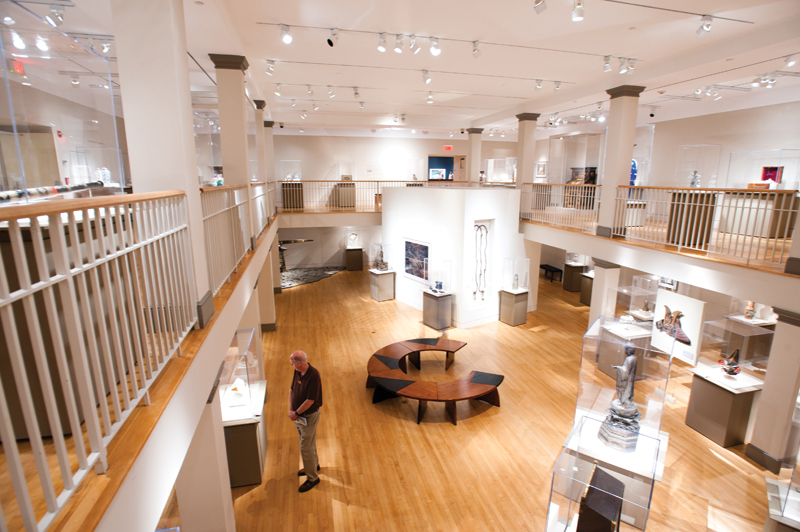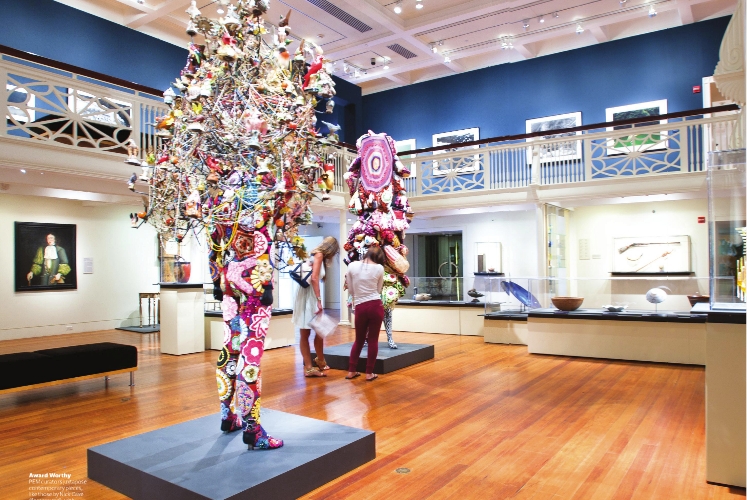Brimming with more than a million representations of artistic ingenuity, the lauded Peabody Essex Museum is premiere among the North Shore’s cultural offerings.
Expanding its footprint at 161 Essex Street in historic downtown Salem is one of the North Shore’s most cherished institutions. Peabody Essex Museum (PEM) is a rich and complex place, and Chief Curator Lynda Hartigan is an astute agent for the rich and complex. Since 2003, Hartigan has set a steady course for steering the museum toward world renown by broadening the scope of its vision and increasing its square footage.
As one of the largest and fastest-growing art museums on the East Coast, the notion of PEM as a “regional” or small-scale museum is erroneous. “We do not think of ourselves as small,” says Hartigan. “We really perceive ourselves as an American museum with global reach and impact.” The 250,000 to 300,000 visitors per year point to the truth in that statement. The result of a merger in 1993 between Peabody Museum of Salem, founded in 1799, and the Essex Institute, created in 1848, PEM is ranked among the Top 20 museums in North America, along with New York’s MOMA, the Getty Museum in Los Angeles, and D.C.’s National Gallery of Art. With an endowment set to hit $630 million by 2016 and extensive expansion plans targeted for completion in 2019, PEM is destined for a Top 10 seat.
Nearly 1.8 million objects comprise PEM’s holdings. Exhibits include American Art, representing over 300 years of New England art and culture; the most comprehensive collection of Asian Export Art in the world; an asse mbly of Japanese Art begun in 1799; the finest collection of maritime art in the nation; the Phillips Library, which holds one of the largest collections associated with an American art museum; 24 historic properties; and Yin Yu Tang, a 200-year-old house that is the only example of Chinese domestic architecture on display in the country. PEM is much more than the sum of its parts—it’s a global ambassador.
The strength of a museum’s collection and exhibitions lies in the hands of its cu – rators and visionaries. Growth depends on pushing the boundaries of PEM’s collective imagination. The curatorial process aims to catapult fresh ideas into existence and weave them into the entire museum experience. As chief curator and part of the executive leadership team, Hartigan says, “I see one of my principal responsibilities as constantly stimulating the creative juices of our staff…a lot of my energy goes into both inspiring and facilitating what they are doing…I don’t want people to get stuck in a certain wayof thinking.”
 |
A recently implemented program gathers together the museum’s nine curators on a quarterly basis for “ideation” sessions during which the curators present a few ideas for shows that they would like to do. Hartigan requires them to “Be concise. Be clear. Be passionate. Bring images.” A 10-minute question and answer session follows each concept sketch. Then, Hartigan determines which ideas “have teeth” and merit further exploration. For those she supports, she asks the curator to do more research and to clarify his or her line of reasoning. Sometimes, she explains why certain ideas didn’t pass muster.
“It’s a win-win process,” says Hartigan. “It gives the curators an opportunity to hear what each is thinking…and [determines] whether we have some opportunities for projects to come together in terms of interesting collaborations.” Some sessions are aimed at getting curators to visit other museums and discover projects in the works. “It’s a matter of trying to be creative and organized at the same time,” explains Hartigan.
From these sessions come ideas for proposals that will be presented in full to PEM’s Exhibition Review Committee, which is made up of the director, deputy director, chief curator, director of exhibition planning, chief marketing officer, and chief philanthropy officer. Each member of the leadership team uses a set of criteria to assess the proposals. They ask questions like: What kind of experience is the exhibition going to provide? How many senses does it engage? Does it take an interdisciplinary approach? Is the idea unexpected? Is it radical?
“We want a balance and a rhythm in our exhibition program between shows that we organize and shows that are organized by other museums, simply because it’s a way to modulate our work time and effort, and our financial resources,” says Hartigan. “It’s less expensive to present a show that has been organized elsewhere, but it also makes sure we have a great mix of what we offer.”
As chief curator, Hartigan feels responsible for holding the team “to a high standard of productivity and flexibility.” She insists on collaboration that brings visitors something extraordinary. “Museums are not just storehouses of creativity,” says Hartigan. “We are not here to simply put on the table an assembly of works done by other people. What goes on in an art museum, in the best possible sense, is really creating an environment in which creativity can be explored on a daily basis by the staff and by the people coming into the museum.”
The visitor experience is at the heart of all PEM efforts. From concept to installation, the museum guest is at the forefront of every decision. “I do want to stress this word ‘experience,’” says Hartigan. “That is really what we are after. The mission of most museums, until recently, has been to collect, preserve, and educate. We do all of those things, but…our mission is very focused on transforming people’s lives by virtue of how we do things, what we choose, how we make information available, how we create opportunities for people to make comparisons and connections.”
Given the varied interests and learning preferences among visitors, curators aim to orchestrate exhibits with fullspectrum appeal. “If someone comes away understanding the Queen Anne style, that’s fantastic,” says Hartigan. “But that’s not really what we are trying to do. What we are trying to do is create a three-dimensional, in-the-real-world, and in-an-actual-space understanding of where creativity, analysis, imagination, and people come together.”
Interactive media plays a limited role. “This is supposed to be a visual and emotional and thoughtful experience, as opposed to a reading experience,” says Hartigan. They have used audio guides, though not often “because it is so expected.” Some people want to read, others to listen, some like a lot of intervention, some want to be left alone. Hartigan makes the point that “if somebody has to read a lot [or] be told what the exhibition is about, there is probably something wrong with the exhibition idea or the installation.” However, docents are active and supply content for those who want it.
Penned signatures of curators, who also give tours, give a personal “voice” to the introductory text of exhibitions and show their hands having had a role in the installation.
The leadership team is currently looking at how to use language in a more inviting, less academic way by posing questions directly to people or creating circumstances in which people are encouraged to ask questions. It is part of a larger mission to further personalize the PEM experience. “What we aspire to do,” says Hartigan, “is provide a landscape of opportunities and experiences that really inspire people to consider what creative expression is, what it can be, and how that can really influence how someone lives their life.”
Sometimes, when talking with visiting groups, Hartigan shares why she organized the installations a certain way and might describe some of the challenges she, the interpreter, and the designer faced. She cites the example of recently sitting on the floor of a gallery looking at paint chips with the designer and how that activity drew a crowd. Creating a bridge between why people are coming into the museum to see a particular kind of art and why and how things have been done the way they have is, according to Hartigan, a great challenge for museums. “Most museums shy away from it,” she says. “We don’t intend to.”
She and her colleagues at PEM recognize that people are curious about what they do and will give it a lot of thought as they move toward the 175,000-squarefoot expansion project. They are looking intently at interpretive strategies and other ways of making their efforts more transparent. They will also decide the key works or types of works that they need to acquire in order to achieve their goals.
Another challenge is determining what they have to offer different age groups. People who frequent museums are typically from a much older demographic. “We realize we cannot wait…to suddenly turn on the switch and say, ‘Now is the time to think about creativity and what it means in your life,’” says Hartigan.
Whether a local resident or out-oftowner, an industry expert or a firsttime museum goer, the visitor is PEM’s soul. And those in charge of its holdings determine its depth. Chief among them is Hartigan, who says of the PEM experience, “Transformation can be on a sliding scale—from minor to major. We welcome all epiphanies.” pem.org

